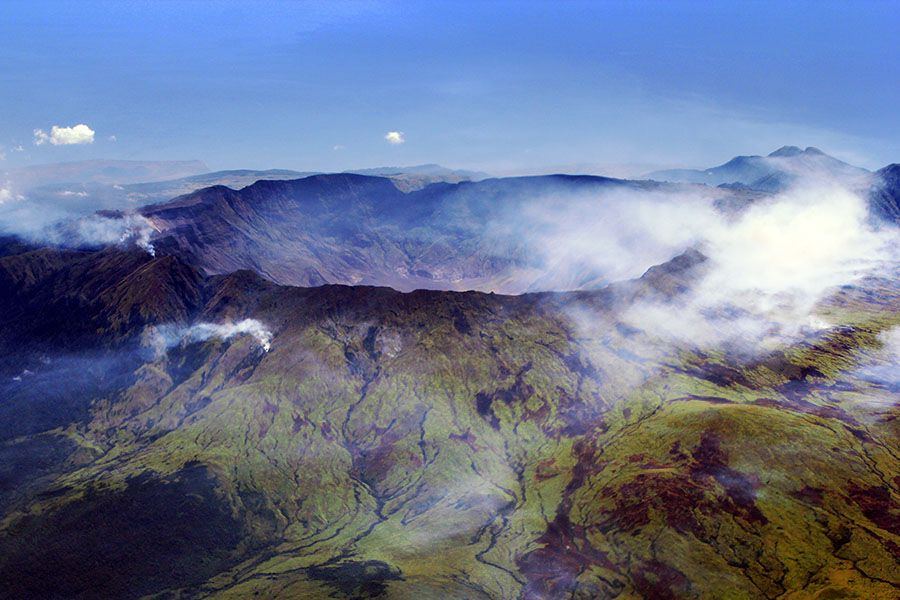
Story Highlights
- Historical event:
- 10 April 1815
- The explosion was even greater than that of Krakatau in 1883. Due to the climate chaos caused by the eruption, the next year (1816) was known as the "Year Without a Summer" even in Europe and North America.
The volcanoes of Indonesia
The geography of the islands that comprise Indonesia is dominated by a large number of volcanoes, which are formed due to subduction zones between the Eurasian and Indo-Australian tectonic plates. Subduction is a process by which one tectonic plate moves under another tectonic plate and sinks into the mantle as the plates converge. Some of the Indonesian volcanoes are notable for their eruptions, including Krakatau (1883) and Lake Toba, an extremely powerful eruption estimated to have occurred some 74,000 years ago and which caused a 6-year-long volcanic winter. It is therefore rather surprising that the Mount Tambora eruption, which occurred precisely 200 years ago, remains relatively little known. The reason for this is most likely the fact that, at the time of the Krakatau eruption, the telegraph was widespread, which allowed news to travel much more quickly. At the time of the Mount Tambora eruption in 1815, however, this was not the case.
The eruption of Mount Tambora
Mount Tambora is located on a peninsula on Sumbawa island, which has a land area of 15,448 square kilometers, with a population of around 1.39 million. Before the eruption, Mount Tambora was 3,4 km high, which made it one of the tallest peaks in the Indonesian archipelago. The accumulation of magma in a large chamber inside the mountain resulted in the eruption which occurred on this day in 1815.
Before the eruption, Mount Tambora experienced approximately 1,000 years of dormancy, but in 1812 the caldera began to rumble, and a dark cloud began to rise from it. The first, moderate-sized eruption occured on 5 April 1815, followed by a thunderous detonation. The explosion was heard as far away as Borneo, Java, and the Molucca Islands (1,400 km away). Many locals at first thought they had heard the sound of cannon fire, and some military units were actually mobilized for war. On the morning of 6 April, volcanic ash began to fall on East Java. On 10 April, what was at first believed to have been the sound of firing guns was heard on 10 April on Sumatra island, more than 2,600 km away. However, all this was merely a prelude.
In the evening of 10 April, the eruptions intensified. The whole mountain was turned into a mass of liquid fire, with three great columns of fire stretching into the sky. Stones up to 20 cm in diameter began to rain down around the area, followed by a cloud of ash. Lava flowed down the mountainside, wiping out the village of Tambora. The cloud of ash spread to cover the islands of Java and Sulawesi (i.e. around 500 km).
The eruption had a VEI (volcanic explosivity index) of 7, the only such explosion unambiguously confirmed as such since the Lake Taupo eruption in 180 AD. The ejected material had a volume of some 160 cubic kilometers, most likely the largest in recorded history. It had approximately four times the energy of the Krakatoa eruption, equivalent to 800 megatons of TNT (16 times more than the Tsar Bomba, the largest nuclear bomb ever tested. The explosion left a caldera measuring almost 7 kilometers across and around 1 kilometer deep. Mount Tambora now measured only 2,851 meters in height, i.e. it lost around one-third of its previous height. The smoke from the eruption reached the stratosphere, an altitude of more than 43 kilometers. Practically all vegetation on the island was destroyed, and uprooted trees could be found floating in the nearby seas for miles around.
The number of people killed by the eruption is estimated at 11,000 to 12,000, including over 90% of the inhabitants of the peninsula, most of whom had not evacuated after the first eruption on 5 April. Most of the deaths caused by the eruption were the consequence of starvation and diseases, since the erupted material ruined the agriculture in the local region. The eruption spread toxic gasses into the atmosphere, causing people to become sick. In addition, the region was struck by tsunamis up to 4 meters in height (moderate size). It is estimated that at least 49,000 more people died from these indirect consequences of the eruption.
At the time, the island was part of the British colonial empire. Lieutenant Owen Philips, sent to investigate the consequences of the eruption, noted: “On my trip towards the western part of the island, I passed through nearly the whole of Dompo and a considerable part of Bima. The extreme misery to which the inhabitants have been reduced is shocking to behold. There were still on the road side the remains of several corpses, and the marks of where many others had been interred: the villages almost entirely deserted and the houses fallen down, the surviving inhabitants having dispersed in search of food.”
Far-reaching consequences
The eruption also caused a global climate anomaly termed the “volcanic winter”, while the next year (1816) was known as the “Year Without a Summer” even in Europe and North America. The eruption led to crop failures and deaths of livestock in the Northern Hemisphere, which in turn led to starvation. Furthermore, diseases such as typhus and cholera flourished. Some estimates claim an additional 200,000 people died because of this.
The monsoon season in China and India was disrupted, forcing thousands of people to flee coastal areas due to flooding. Fine ash particles remained in the atmosphere from a few months up to a few years, and were spread throughout the world causing various optical phenomena such as prolonged and brilliantly-colored sunsets.
Interestingly, an excavation in 2004 uncovered the remains of a village and two adults buried under more than three meters of ash by the 1815 eruption, which were preserved in positions they had occupied in 1815. This led to the site being nicknamed the “Pompeii of the East”. Indeed, the sudden and rapid nature of the Tambora eruption shows many similarities with the one at Mount Vesuvius in 79 AD.
In a truly unusual turn of events, the failure of oat crops in Germany made it expensive to maintain horses, which led to Karl Drais’s invention of the velocipede, the forerunner of the bicycle. It also influenced the writings of Mary Shelley and John Polidori, two major pioneers of horror literature. Namely, as part of a writing contest arranged by Lord Byron, Polidori wrote The Vampyre (a major inspiration for Bram Stoker’s Dracula), while Shelley wrote Frankenstein.




